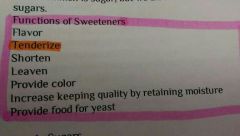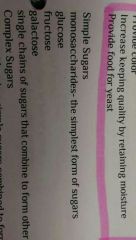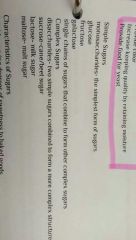![]()
![]()
![]()
Use LEFT and RIGHT arrow keys to navigate between flashcards;
Use UP and DOWN arrow keys to flip the card;
H to show hint;
A reads text to speech;
176 Cards in this Set
- Front
- Back
|
function of sweteners |

|
|
|
simple sugars
|

|
|
|
complex sugars
|

|
|
|
hygroscopic
|
attract and hold water
|
|
|
inverted sugars
|
sucrose is heated with an acid , breaks down into two simple sugars. dextrose and levulose.
|
|
|
characteristics of inverted sugars
|
extremely hygroscopic
resistance crystallization |
|
|
examples of inverted sugars
|
corn syrup
honey maple syrup |
|
|
invert sugars -- % sweeter than regular sugar
|
30%
|
|
|
types of refined sugars
|
granulated
sanding pearl |
|
|
why do u want finer granules
|
dissolve better and better for creaming with fats
|
|
|
Brown sugar
|
85-92% granulated with added impurities.
|
|
|
syrup
|
1 or more types of sugars dissolved in water.
|
|
|
simple sugar
|
1:1 sugars dissolved in water
|
|
|
dessert syrup
|
flavored simple syrup
|
|
|
molasses
|
concentrated sugarcane juice
|
|
|
glucose corn syrup
|
part of the process of corn starch breaking down into smaller glucose molecules.
|
|
|
invert sugar syrups
|
trimoline; adds maisture retaining properties.
|
|
|
honey
|
natural sugar syrup
|
|
|
malt syrup
|
used in yeast breads, made from sprouted barley.
|
|
|
function of liquids
|
provide moisture
essential for gluten production |
|
|
functions of milk
|
contributes to: texture, flavor,crust color, keeping quality, and nutritional value.
|
|
|
pasteurization
|
milk is heated to 161°f for 15 seconds to kill bacteria, then cooled quickly.
|
|
|
ultrapasturization
|
milk is heated to 275℉ for 1-2 seconds to kill organisms
|
|
|
homogenization
|
milk is forced through very tiny holes in a screen, breaks fat into particles so small they suspend in milk.
|
|
|
milk contains enzymes that do what to gluten
|
harm
|
|
|
how do u prevent milk enzymes from harming gluten?
|
heated milk
|
|
|
buttermilk
|
contains lactic acid rather that lactose.
|
|
|
types of leaveners
|
chemical
biological mechanical |
|
|
chemical leaveners
|
baking soda
baking powder baking ammonia |
|
|
biological leaveners
|
yeast
|
|
|
mechanical leaveners
|
steam
|
|
|
how do mechanical leaveners work
|
increase size of air cells to expand structure of baked goods.
|
|
|
what makes up air cell walls
|
gluten and egg proteins
|
|
|
how are air cells formed
|
formed in mixing process
|
|
|
how do air cells assist in leavening process.
|
leavening gases are trapped in air cells that are formed in the mixing process. as gases expand or are created by leaveners or heat the cells expand. cell walls are formed by gluten and egg proteins, as proteins set, they trap gasses and form the crumb .
|
|
|
yeast is found where
|
naturally in the air and added intentionally
|
|
|
how does yeast work
|
fermentation: yeast produces enzymes that change complex sugars into simple sugars, then simple sugars are changed into CO2 gas and alcohol.
|
|
|
yeast are inactive at what temperature?
|
34℉
|
|
|
yeast do what from 60-70℉
|
slow action
|
|
|
at what temperature do yeast grow best
|
70-90℉
|
|
|
yeast reaction slows above what temperature?
|
100℉
|
|
|
yeast die at what temperature
|
140℉
|
|
|
fresh yeast
|
moist and perishable; crumble and add in directly or soften in warm water.
|
|
|
active dry yeast
|
must be dehydrated with at least 4 times it's weight in water. contains dead yeast cells due to drying process.
|
|
|
instant dry yeast
|
does not need to be dehydrated works well in short fermentation formula.
|
|
|
osmotic dry yeast
|
sugar can attract too much water and inhibit yeast fermentation.
|
|
|
baking soda
|
sodium bicarbonate; releases CO2 in presence of moisture and acid; does not require heat; bake right away or leavening will be lost.
|
|
|
baking powders
|
baking soda + acid; single-acting=require only moisture to act; double-acting = will release some gas when cold , but need heat for a complete reaction.
|
|
|
baking ammonia
|
ammonium carbonate and ammonium bicarbonate; decomposed to produce CO2 gas; released quickly, but needs to be done in small batters.
|
|
|
creaming
|
process of beating fat and sugar together to incorporate air.
|
|
|
foaming
|
process of beating eggs with or without sugars to incorporate air
|
|
|
water expands to ---- x it's original volume when it turns to ____
|
1,100 times it's original volume when it turns to steam.
|
|
|
Eggs are the ________ _______ of the SLLEFF products.
|
most expensive.
|
|
|
function of eggs
|
structure builders
emulsifiers leaveners shorteners provide moisture provide flavor and color provide nutritional value |
|
|
how do eggs provide structure
|
through protein coagulation
|
|
|
how do eggs emulsify a batters/ dough
|
yolks contain natural emulsifiers to produce smooth batters
|
|
|
how do eggs act as leaveners
|
beaten eggs incorporate more air.
|
|
|
how do eggs act as shorteners
|
fats in yolks shorten products by inhibiting some gluten production.
|
|
|
Eggs provide moisture how
|
Eggs are mostly water; make sure to account for moisture in products.
|
|
|
Eggs provide color by___
|
yellow from yolks as well as Browning of cooked egg proteins.
|
|
|
what nutritional value do eggs add
|
proteins, iron, fat and several vitamins.
|
|
|
6 pts of an egg
|
yolk
white shell air cell chalazae |
|
|
egg yolk
|
fat and proteins; high in iron; weight approx .5 oz
|
|
|
thick and thin egg whites
|
albumin, low fat, silver, weight approx 1oz
|
|
|
egg shell
|
protective cover; loses moisture; absorbs odors
|
|
|
egg air cell
|
provide air to egg as well as cushions egg in shell
|
|
|
chalazae
|
strands that hold egg in center of shell
|
|
|
what should a fresh egg look like
|
you want a firm white and yolk that stands up high when broken on to a flat surface.
|
|
|
how are eggs graded?
|
AA A and B
|
|
|
to be jumbo a carton of eggs must weigh?
|
30oz
|
|
|
27 oz carton of eggs are what size
|
extra large
|
|
|
carton of large eggs weigh what
|
24oz
|
|
|
carton of medium eggs weigh what
|
21oz
|
|
|
carton of small eggs weigh what
|
18oz
|
|
|
how many eggs does it take to make a pound?
|
9.5
|
|
|
one whole egg weighs what
|
1.67oz
|
|
|
how many egg whites does it take to make a pound
|
16
|
|
|
how many yolks does it take to make a lb
|
24
|
|
|
function of flour
|
structure
absorbs liquid contributes flavor contributes color nutritional value |
|
|
flour adds structure by
|
provided through gluten development
|
|
|
why is it important that flour absorbs moisture
|
driers are important in the baking process and help bind ingredients together
|
|
|
6 classes of wheat
|
hard red winter
hard red spring hard white soft white soft red winter durum |
|
|
hard red winter wheat
|
used primarily for bread flour, high proteins.
|
|
|
hard red spring wheat
|
highest protein
|
|
|
hard white wheat
|
high protein; grown in small quantities for bread flour.
|
|
|
soft white wheat
|
low protein used for pastries, cakes ect
|
|
|
soft red winter wheat
|
low protein used in cakes and pastry flour
|
|
|
durum wheat
|
hard wheat also known as semolina, used in pastas
|
|
|
steps to milling wheat
|
1 separate endosperm, from bran and germ
2 grind endosperm into fine powder |
|
|
bread flour
|
11-13% protein, sometimes has malt flour added
|
|
|
high gluten bread flour
|
used in hard crusted products; pizza and bagels. 14% protein
|
|
|
cakes flour
|
soft smooth texture, pure white color 8% proteins
|
|
|
pastry flour
|
slightly stronger than cakes flour , creamy white color, 9% protein
|
|
|
ap flour
|
10-11.5% protein used a lot when food costs or storage are of concern.
|
|
|
durum flour
|
12-16% protein
|
|
|
self rising flour
|
baking powder and salt added
|
|
|
whole wheat flour
|
whole kernel ground and used, 12-13% proteins, brand breaks gluten strands
|
|
|
brand flour
|
flour with added brand flakes
|
|
|
cracked wheat
|
meal of coarse ground wheat kernels
|
|
|
flour treatments and additives |
enzymes, aging and bleaching agents, nutrients, dough conditioners, vital wheat gluten.
|
|
|
enzymes added to flour
|
amylase or diastse helps to break starch down into sugar for yeasty beasties.
|
|
|
aging and blanching agents added to flour |
bromates and ascorbic acid mature gluten, chlorine bleaches flour and matures gluten |
|
|
nutrients added to flour |
iron and b vitamins |
|
|
dough conditioners |
improve gluten development, aid yeast fermentation, delay staling |
|
|
vital wheat gluten |
75% gluten by weight |
|
|
parts of wheat |
germ Endosperm bran
|
|
|
Wheat Germ |
Seed of wheat kernel, will become a wheat plant if sprouted; High in fat |
|
|
Endosperm |
white, starchy part of the wheat kernel; ground into flour; starch, moisture, fat , sugar, mineral and other components |
|
|
Bran |
hard outer covering; high in fiber, b vitamins, fat, protein and minerals |
|
|
two proteins that create gluten |
Glutenin and gliadin |
|
|
How is gluten created |
when glutenin and gliadin are combined with water and agitated |
|
|
What does gluten do? |
provides the basic structure of baked goods; holds all other ingredients in suspension; surrounds air cells |
|
|
flour grades |
patent flour clear flour straight flour
|
|
|
Patent flour |
1st stream; highest grade; interior of the endosperm |
|
|
Clear flour |
endosperm left after patent flour is removed |
|
|
straight flour |
made from entire endosperm; combines all streams of the milling process |
|
|
extraction |
amount of flour milled from a given amount of a grain |
|
|
parts of flour |
starch protein moisture gums fats ash pigments
|
|
|
Starch in flour |
complex carbs; absorb water and swell during mixing;some break down to sugar to feed yeast. |
|
|
what percent of flour is starch |
68-76% |
|
|
What part of flour is protein |
6-18% |
|
|
protein in flour |
80% of protein in flour is gluten; amylase/diastase breaks down starch into simple sugars |
|
|
Moisture in flour |
11-14% |
|
|
Gums in flour |
2-3% Pentosans absorb 10-15x their weight in water |
|
|
fats in flour |
1% spoil quickly |
|
|
ash in flour |
natural mineral content in flour |
|
|
pigments in flour |
carotenoids; orange-yellow in color; oxygen will bleach with time
|
|
|
what % of protein is good for mechanized processes |
13.5% |
|
|
flour with 10.5-12% protein is best for what type of processing |
hand made doughs |
|
|
Corn meal |
no gluten forming proteins; high in other proteins |
|
|
spelt flour |
conains gluten proteins; rich in dietary proteins; great for vegetarian diets
|
|
|
oats |
some glutenin and gliadin, but dont form gluten structure, many varieties |
|
|
buckwheat |
a seed not a grain, used for pancakes, crepes etc |
|
|
soy |
legume not a grain, high in fat and protein |
|
|
rice |
most often used gluten free flour |
|
|
rye flour |
does not contain enough glutenin to form gluten on its own; general do a 25-45% rye to 60-75% wheat flour mix; range from light to whole rye; rye meal and rye blend are also available |
|
|
major functions of fats |
provide tenderness provide flakiness in broken and laminated dough assist in leavening contribute moistness contribute flavor prevent staling
|
|
|
Minor functions of fats |
contribute color provide fine crumb add creaminess conduct heat provide bulk to icing and fillings promote smoothness blend flavors-masks off flavors |
|
|
fats provide tenderness by.. |
coat structure builders |
|
|
fats assist in leavening by |
incorporating air cells through creaming |
|
|
how do fats contribute color |
milk solids brown during baking |
|
|
how do fats provide finer crumb |
incorporate smaller air cells |
|
|
shortening |
any group of solid fats, usually white and tasteless that are specially formulated for baking
|
|
|
regular shortening (aka plastic shortenings) |
made of varying degree of hardness; have a great creaming ability, melt at high temps |
|
|
oils |
liquid fats; not often used as shortening bc they spread too much; generally reserved for heat transfer or release agents; some cakes call for oils as the fat
|
|
|
lard |
rendered pig fat; great plasic quality, not often used after development of medern shortenings |
|
|
high ratio plastic shortening |
devised for use in batters with a high ratio of sugar and liquid to flour; contain added emulsifiers, does not cream well |
|
|
high ratio liquid |
less hydrogenated and pourable; effective in high ratio cakes due to added emulsifiers make mixing easier |
|
|
how to store fats? |
air tight containers |
|
|
emulsion |
uniform mixture of two normally unmixable substances |
|
|
Saturated fat |
fatty acids are made of long chains of carbon atoms with hydrogen atoms attached if all carbons have hydrogen, the fat is saturated; sold at room temp |
|
|
unsaturated fat |
fatty acids are made of long chains of carbon atoms with hydrogen atoms attached if some carbons do not have a hydrogen the fat is unsaturated; liquid at room temp |
|
|
margarine |
made from hydrogenated fats; added flour, emulsifiers, and coloring agents, butter flavored shortening |
|
|
butter |
made from sweet cream, available salted and unsalted
|
|
|
uses of starches |
used to thicken products |
|
|
Cornstarch |
sets up almost like gelatin when cooled |
|
|
waxy maize |
modified food starch, do not break down when frozen; set up clear |
|
|
Instant starches |
precooked so they thicken cold liquids without further cooking |
|
|
gelling agents |
gelatin
|
|
|
gelatin |
water soluble protein extracted from animal connective tissue; proteins form long strands that trap liquid and keep it from flowing |
|
|
pectin |
vegetable based gum makes a clear gel; needs an acid or sugar to gel completely |
|
|
tree nuts |
almonds brazil nuts cashews chestnuts coconut hazelnut macadamia nuts pecans pine nuts pistachios walnuts
|
|
|
Kernel paste |
peanut, walnut and almond
|
|
|
marzipan |
almond paste with powdered sugar
|
|
|
praline paste |
hazelnut paste
|
|
|
citric acid |
found in citrus fruits; used to make candy sour, used in cheese making
|
|
|
lactic acid |
found in milk
|
|
|
tartaric acid |
found in wine (cream of tartar)
|
|
|
Acetic acid |
found in vinegar
|
|
|
malic acid |
found in apples |
|
|
acids in baked goods do what. |
help in the leavening process, help sugars resist crystalization, help curlture milk processes |
|
|
what plant does cocoa come from |
theobrama cacao tree
|
|
|
cocoa beans consist of what two parts |
cocoa powder and cocoa butter
|
|
|
couventure |
fr for coating; finest chocolate you can get |
|
|
tempering |
process for preparing couverture for use
|
|
|
white chocolate |
contains no cocoa; cant legally be called chocolate. |

